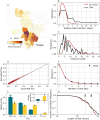EPINEST, an agent-based model to simulate epidemic dynamics in large-scale poultry production and distribution networks
- PMID: 38381804
- PMCID: PMC10911595
- DOI: 10.1371/journal.pcbi.1011375
EPINEST, an agent-based model to simulate epidemic dynamics in large-scale poultry production and distribution networks
Abstract
The rapid intensification of poultry production raises important concerns about the associated risks of zoonotic infections. Here, we introduce EPINEST (EPIdemic NEtwork Simulation in poultry Transportation systems): an agent-based modelling framework designed to simulate pathogen transmission within realistic poultry production and distribution networks. We provide example applications to broiler production in Bangladesh, but the modular structure of the model allows for easy parameterization to suit specific countries and system configurations. Moreover, the framework enables the replication of a wide range of eco-epidemiological scenarios by incorporating diverse pathogen life-history traits, modes of transmission and interactions between multiple strains and/or pathogens. EPINEST was developed in the context of an interdisciplinary multi-centre study conducted in Bangladesh, India, Vietnam and Sri Lanka, and will facilitate the investigation of the spreading patterns of various health hazards such as avian influenza, Campylobacter, Salmonella and antimicrobial resistance in these countries. Furthermore, this modelling framework holds potential for broader application in veterinary epidemiology and One Health research, extending its relevance beyond poultry to encompass other livestock species and disease systems.
Copyright: © 2024 Pinotti et al. This is an open access article distributed under the terms of the Creative Commons Attribution License, which permits unrestricted use, distribution, and reproduction in any medium, provided the original author and source are credited.
Conflict of interest statement
The authors have no competing interests to declare.
Figures







Similar articles
-
Spatial distribution of poultry farms using point pattern modelling: A method to address livestock environmental impacts and disease transmission risks.PLoS Comput Biol. 2024 Oct 1;20(10):e1011980. doi: 10.1371/journal.pcbi.1011980. eCollection 2024 Oct. PLoS Comput Biol. 2024. PMID: 39352881 Free PMC article.
-
Modelling H5N1 in Bangladesh across spatial scales: Model complexity and zoonotic transmission risk.Epidemics. 2017 Sep;20:37-55. doi: 10.1016/j.epidem.2017.02.007. Epub 2017 Feb 21. Epidemics. 2017. PMID: 28325494
-
Backyard poultry: exploring non-intensive production systems.Poult Sci. 2024 Feb;103(2):103284. doi: 10.1016/j.psj.2023.103284. Epub 2023 Nov 17. Poult Sci. 2024. PMID: 38056053 Free PMC article. Review.
-
Poultry farmer response to disease outbreaks in smallholder farming systems in southern Vietnam.Elife. 2020 Aug 25;9:e59212. doi: 10.7554/eLife.59212. Elife. 2020. PMID: 32840482 Free PMC article.
-
[Natural history of Avian Influenza or "chicken flu". Present and future health analysis].An R Acad Nac Med (Madr). 2005;122(2):215-28; discussion 228-32. An R Acad Nac Med (Madr). 2005. PMID: 16463571 Review. Spanish.
References
Publication types
MeSH terms
LinkOut - more resources
Full Text Sources
Medical

